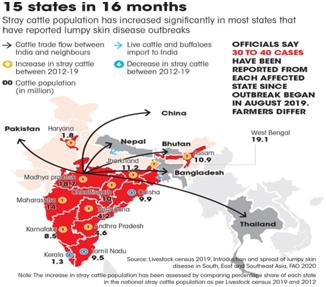‘Lumpy Skin Disease’
-
Context
A disease, Lumpy Skin Disease (LSD) is spreading among cattle across several villages in the Kammana in Kerala’s Wayanad district.
-
Background
- Already reeling under the COVID 19 woes, the outbreak of lumpy skin disease has dealt a crippling blow to cattle rearers and dairy farmers in India.
- LSD was first reported in Asia and the Pacific region in 2019 in north-west China, Bangladesh and India.
- During the northern summer of 2020, LSD has continued its spread across continental Asia with many members in south and south east Asia confirming outbreaks.
- The disease is now spreading rapidly among cattle and has significantly hit the production of milk.
-
Analysis
What is lumpy skin disease?
- Lumpy skin disease (LSD) is a viral illness that causes prolonged morbidity in cattle and buffaloes.
- It is a poxviral disease.
- It appears as nodules of two to five centimetre diameter all over the body, particularly around the head, neck, limbs, udder and genitals.
- The lumps gradually open up like large and deep wounds.
- In some cases, under 10 per cent according to the Food and Agriculture Organization (FAO) — the infected animal succumbs to the disease.
- LSD virus is a member of the genus Capripoxvirus and the family Poxviridae. It is closely related antigenically to sheeppox virus and goatpox virus.
- Transmission: The LSD virus easily spreads by blood-sucking insects like mosquitoes, flies and ticks and through saliva and contaminated water and food.
- The virus is not zoonotic and doesn’t infect humans through consumption of milk or meat.
- Treatment: Veterinarians say no treatment is available for the disease.
- The World Organisation for Animal Health (OIE) declares it as a notifiable disease.
- This means a country must inform OIE about any outbreak of the disease so that it can be contained.
-
Geographical distribution
- Historically, LSD has remained confined to Africa, where it was first discovered in 1929, and parts of West Asia.
- But in recent years, the disease has spread to territories beyond the endemic areas. In 2015, it made an incursion into the European part of Turkey and Greece.
- The next year, it created havoc in the Balkan and Caucasian countries and Russia.
- However, since its arrival in Bangladesh in July 2019, LSD is spreading across Asia in epidemic proportions.
- At least 23 countries in south Asia, east Asia and southeast Asia are now at risk of LSD, which is emerging as a trans-boundary animal disease.
Spread in India
- In India, which has the world’s highest 303 million heads of cattle, the disease has spread to 15 states within just 16 months.
- In fact, in August 2019, when the first outbreak of LSD was reported from Odisha, five districts were grappling with the exotic cattle pox
- However, no consolidated figure is available with the Department of Animal Husbandry and Dairying (DAHD) regarding the actual spread of LSD in the country or economic losses incurred by farmers.
- Unofficial estimates show at least 5,000 heads of cattle might have contracted LSD in Kerala alone since December 2019.
-
Impact on economy
The infectious nature of LSD and its implications cause significant economic losses to farmers. Major reasons for the loss are as given below:
- decreased milk production
- abortions and infertility
- damaged hides due to cutaneous nodules and fibrous tissue growth
-
Issues/Challenges
- Unofficial movement: Given the gap between supply and demand for animal protein in Bangladesh and disparities in livestock prices with India, unofficial imports of livestock including cattle and buffaloes to meet animal protein demand takes place. The flow of informal cross-border movements of cattle, usually by foot, likely led to the spread of the infection.
- Un-followed safety advisories: The government issues advisories to states to follow safety measures. But such protocols are barely followed in a country where livestock is mostly raised by landless or marginal farmers and under backyard systems.
- Conducive environment: Insects like ticks, biting flies, mosquitoes are anyway more prevalent in tropical climatic conditions of India. As unseasonal rains and floods become frequent, they will provide a conducive atmosphere for insect growth and multiplication and infectious disease vectors will no longer be restricted to a few months.
- Poor infrastructure and climate change: Changing climate and poor animal healthcare infrastructure act in favour of LSD.
- Carelessness: The disease can be checked if the animal is treated within the initial few days. But most of the times, people do not give importance to skin diseases in cattle. They think it will heal naturally.
-
What needs to be done?
- Tracing source of infection: Tracing the source of infection plays a critical role in containing the spread of any contagious infection. But the authorities are still clueless about how LSD was introduced to India.
- Watch on trade: The long porous borders between India, Nepal and Bangladesh allow for a significant amount of bilateral and informal animal trade, including cattle and buffaloes. This needs to be regulated through various measures such as following biosecurity measures, putting checkposts on borders for interstate movement, and isolation.
- Vaccination and treatment: As of now, several states have authorised the use of goat pox vaccine for treating LSD as the virus is antigenically similar to sheep and goat pox. It needs to be administered on all cattle within 5 km zone of the epicentre.
-
Conclusion
The disease will have a devastating impact on the country, where most dairy farmers are either landless or marginal landholders and milk is among the cheapest protein source. The disease needs to be checked and controlled immediately. Otherwise, it will spread rapidly and have a lasting impact on economy.


